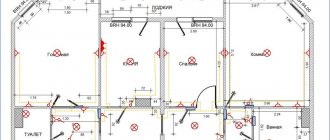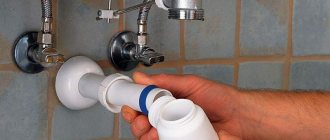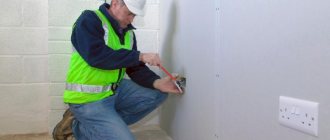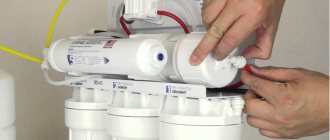Every house has switches, and more than one. We have all become accustomed to these small devices and consider them an integral part of our everyday life. It may seem that they are all designed the same and are extremely easy to install. However, this is not at all true - the devices are very diverse.
Agree, it would be a good idea for any home craftsman to know which model is best to use and how to install the light switch so that the device works flawlessly.
The article is devoted to solving these questions. We will outline the operational features of different switches, and also provide detailed instructions for installing open, hidden and walk-through models.
Wiring: open or hidden option
Despite the fact that installing a switch may seem like a very simple matter, there are a large number of nuances that a novice electrician must know.
First you need to decide on the type of wiring.
Open wiring is still used in everyday life. It is especially loved by designers who create interiors in retro or loft style.
Electrical wiring is an essential element present in every home.
There are two types of it:
- Open . The wires are laid on top of the wall. They can be secured with decorative rollers or covered with plastic cable ducts.
- Hidden . The wire is laid inside the wall. To do this, channels are cut into its surface into which the cable is laid. After installation, the grooves are sealed with mortar.
Each type of wiring uses a different type of switch. For an open system, choose overhead models that are placed directly on the wall. They are easily recognizable because they are very visible on the surface.
This type of switch was the first to appear and has changed little over the past decades. For closed wiring, internal or built-in models are used.
Image gallery
Photo from
Switch-socket block for open wiring
Benefits of installing external switches
Switches for hidden electrical wiring
Disadvantages of hidden wiring switches
They are installed in a recess that is previously prepared in the wall. The dimensions of the hole are selected depending on the dimensions of the switch. It is attached inside the recess using special spacer legs.
There is another type of built-in devices - with mounting plates. This option is more convenient to install. After installation, the internal switches practically do not protrude above the wall plane.
Where to start?
To get started you need:
- decide what type of switch needs to be installed;
- Prepare the tools and materials that will be required.
Choosing a new switch
When choosing a device, you should pay attention to the following parameters:
- Maximum power. This device parameter is calculated using a simple mathematical formula. This indicator determines the permissible load, and it is especially critical when using conventional incandescent lamps. The total power consumption of the luminaire should not be higher than that indicated on the switch. If only the permissible current in amperes is marked on the case, you can calculate the maximum power by multiplying this value by 250. For example, 6 A × 250 V = 1500 W or 1.5 kW. To reduce energy consumption, it is recommended to use LED lamps.
- Case material. It determines the temperature stability of the device. Large rooms with powerful fixtures will require breakers that can handle heavy loads. The type of housing in which the contacts are placed is important here. It can be made of ceramic or plastic. Ceramic cases are immune to temperature changes; they work properly even if a large current flows in the circuit. For an ordinary apartment in a multi-story building, a breaker with a plastic case is suitable.
- Number of keys on the switch. The number of buttons is selected based on the type of lamp, existing wiring capabilities and connection diagram. In the kitchens of ordinary apartments, appliances with one key are most often used, and in living rooms - with two. Also, two-button devices are used in separate bathrooms.
- Mounting type. For internal switches, the housing is hidden in the wall, and on the surface there is only a cover with a socket. External switches are almost never used in modern apartments. Their distinctive feature is a thick body and open wiring connected to the device (not hidden in the wall). Illuminated switches are most often installed in the corridors at the entrance to the apartment, so as not to look for them in the dark.
For bathrooms, you need a device with a moisture resistance rating of at least IP 44, and when installed outdoors (for example, in a private house) - IP 55 or higher.
Tools and materials for work
To change the switch you need to prepare:
- indicator for finding a phase wire;
- a powerful flat or shaped screwdriver;
- wire cutters or pliers;
- cable stripper.
Switch wire switching method
Before you begin installing the switch, you need to know that the internal fastenings of the wires in the device may be different. Two switching methods are used.
Screw type clamp
The screw type contact is tightened with a screwdriver. First, approximately 2 cm of the wire is cleared of insulation, then it is located under the terminal and secured. It is extremely important that not a millimeter of insulation remains under the terminal, otherwise it will begin to melt, which is very dangerous.
Screw-type clamps are optimally used for aluminum wires, which tend to heat up and become deformed. To restore functionality, it will be enough to tighten the contact (+)
This connection is especially good for aluminum wires. They heat up during operation, which eventually leads to deformation. In this case, the contact begins to heat up and spark.
To solve the problem, it will be enough to tighten the screw. The wires, sandwiched between two flat contact plates, will “fall into place” and the device will operate without heating or sparking.
Non-screw type clamp
Represents contact with the pressure plate. Equipped with a special button that adjusts the position of the plate. The wire is stripped of 1 cm of insulation, after which it is inserted into the contact hole and clamped. The whole procedure is very quick and easy.
The non-screw clamp is extremely easy to install, which is why experts recommend that novice electricians work with terminals of this type
The design of the terminal ensures high reliability of the resulting connection. Non-screw terminals are best used for copper wiring.
It must be admitted that screw and non-screw clamps provide approximately the same reliability and quality of connections. However, the second option is easier to install. It is this that experienced specialists recommend using for novice electricians.
Installation of various products
In order for the switch to function correctly, it is necessary to carry out installation taking into account all the rules and recommendations. Only in this case will it be possible to achieve the desired result and reduce the likelihood of any unforeseen situation occurring.
Single-key device
Of the large number of products, the easiest to connect is a single-key switch. This installation option is advisable to use for a lighting device that operates with one lamp.
The process of connecting a single-key device is simple and consists of the following steps:
- The necessary markings are applied to the wall, which will correspond to the lines for laying the wires.
- Using a hammer drill, channels are cut. Their width should be slightly larger than the diameter of the cable, and their depth should be another 3 millimeters more. A small margin is made so that the wire fits easily in the gutter and does not interfere with the sealing with putty.
- The room is completely de-energized.
- A cable is taken and its two cores are routed from the junction box to the switch.
- The same wire is led from the box to the lighting fixture (only “zero” is used).
- A phase cable is laid from the lamp to the switch.
- At the next stage of installation, a hammer drill is used again. A special attachment is installed on it and a recess is made in the wall for the switch. Its location should be chosen in advance.
- A glass is inserted into the resulting recess. The wiring is inserted into a special hole located in the upper part.
- Channels and remaining voids are sealed with putty. This work is quite painstaking, but simple.
- While the applied mixture hardens, the purchased switch is disassembled. To do this, use a screwdriver to pry up the key and carefully remove it. After this, the facing panel is removed.
- The ends of the wires located in the socket box are exposed and stripped. This work can be done using a special knife or any available cutting object.
- Take the disassembled device and connect the wires to the contacts. There they are securely fixed using the supplied fasteners.
- The device is inserted into the glass and aligned with the wall.
- The side screws are tightened and the switch is securely fixed.
- The facing panel is put on the device and the key is inserted.
- The power supply is turned on in the room and the switch is checked for functionality.
https://youtube.com/watch?v=McoyH4e14Lo
Double product
Installing a light switch with two keys is a little more complicated. To do this job well, you will need experience and knowledge.
The two-key device is installed following the following sequence of actions:
At the very beginning, the room is disconnected from power. The presence of voltage in the network is checked using an indicator screwdriver. If the tester shows no current, then the supply wire is connected. It is then connected to the protective device using a three-wire cable. This type of wire is used to increase durability and to be able to ground the lighting fixture. The cable is led from the safety structure to the distribution box, and from it to the section of the wall where the two-key switch will be located
In both cases, it is important to leave a small supply of wiring (at least 15 centimeters) to prevent shortages. At the next stage, two wires are connected to the distribution box, which will close the lighting circuit. The edges of the cable coming from the protective device are stripped of the insulation layer. The purchased switch is removed from the packaging. Then both keys and the decorative panel are removed from it. The remaining part of the device is brought to the junction box, where the wires are connected to it
This should be done in accordance with the color of the insulating layer. As a result, the phase conductors should be located on the left side, and neutral conductors on the right. All contacts are tested for strength and supplemented with a wire coming from the ground. The switch is securely attached to the wall, and then a decorative panel and keys are placed on it. The power supply in the room is restored and the installed switch is checked in all operating modes.
A three-key device is connected using the same principle.
Main types of switches
The time has long passed when all models were approximately the same and differed only in appearance. Today, the manufacturer produces a variety of types of switches. Based on the type of switching on/off, all of them can be divided into several groups.
No. 1: Keyboard type devices
Very simple and reliable design. The basis of the device is a swinging mechanism, which is pressed by a spring. When you press a key, it closes a contact, which turns the electrical device on or off.
For the convenience of consumers, one, two and three-key switches are available. This makes it possible to control not only one, but several lamps at once.
No. 2: Switches or changeover switches
Externally, these devices are indistinguishable from their keyboard counterparts, but their operating principle is completely different. When you press a key, the devices open one electrical circuit and transfer the contact to another.
This allows simultaneous control of lighting from two, three or even more places. Complex circuits that involve more than two switches are supplemented with crossover elements.
Dimmers not only turn on the lighting, but also regulate its intensity. There are also multifunctional types of devices that can simulate presence, operate on a timer, and much more.
#3: Dimmers or Light Intensity Controllers
A switch that allows you to adjust the lighting intensity. The external panel of such a device is equipped with keys, a rotating button or infrared sensors.
The latter option assumes that the device can receive signals from the remote control. Complex dimmers can perform several functions: activate dimming mode, simulate presence, turn off lights at a specified time.
The criteria for choosing a dimmable switch are described in this article.
No. 4: Switches with built-in motion sensor
Devices react to movement. The appearance of people is registered by a sensor that activates the lighting and turns it off if there is no movement. To operate the switch, an infrared sensor is used, which is capable of analyzing the intensity of infrared radiation and distinguishing a person from other objects.
Multifunctional switches with a motion sensor can not only turn on lighting fixtures, but also activate video cameras, sirens, etc.
No. 5: Touch-type devices
Turn the lighting off/on by lightly touching the sensor. Varieties are available that are triggered when a hand is passed near their body. The main difference between touch switches and traditional analogues is the presence of microcircuits.
This eliminates the risk of a short circuit, which significantly increases the service life of both the switch itself and the lighting fixture.
There are many types of switches. Illuminated models are designed to facilitate orientation in dark rooms
Lighting control circuit for a single-lamp chandelier, lamp, sconce
This scheme can be called the simplest. To turn on/off the lamp, simply install a switch on the phase wire of the lamp's power supply.
Illuminated switch
Everyone is familiar with convenient backlit switches. For some manufacturers, switch lighting is installed separately (wiring with a diode). The backlight is connected as follows. However, in practice, such a concept for installing a single-key switch cannot be implemented everywhere. For example, to control the operation of a sconce with a switch on the power cable.
How to choose the “right” place for the switch
Choosing a place to install the switch is a personal matter for each owner. However, there is a set of industry requirements that regulate this issue. This is due to the fact that laying electrical wiring is quite an expensive undertaking and redoing it every time is expensive and too troublesome.
Experts recommend installing all switches in the house at the same height and the switching position should be common for all.
The devices are usually mounted at the height of door handles, which correlates well with the development of muscle memory. Thus, when entering a room, a person presses a key automatically, without even noticing it.
Another important point: the switch in the room must be positioned so that there is a distance of about 15-20 cm between it and the doorway. This way a person can grab the door handle with one hand and press the key with the other.
For living rooms, it is customary to install switches only indoors. For common areas, such as bathrooms, closets or corridors, switches located outside the room are most often used.
If there are small children in the house, you should not “lift” the switches up. The restless period when the baby will “play around” with the light will pass very quickly, and the inconvenience from the location of the switches will remain for a long time.
The design of the switch is extremely simple. Its main elements: mechanism on the mounting plate, keys and decorative protective panel
Understanding the system
Before installing a switch with your own hands, you need to choose the most suitable one, focusing on the existing wiring in the house, personal preferences and financial capabilities. So, the main modifications are the following:
- Hidden, when the wires are placed inside the wall;
- External with wires on the wall.
Also, in addition to the types of installation of switches, they are classified according to other parameters:
- Single-key and two-key;
- With and without backlight;
- With and without indicator light.
The latter types do not differ in installation, however, the instructions for installing a hidden and external type switch differ. Below is a step-by-step algorithm for each option with a photo and detailed description.
Surface Mount Switch Installation Procedure
Such devices are used for open wiring and where for some reason it is impossible to make a hidden connection.
Let's look at the installation procedure using the example of a fully factory-assembled single-key switch. To connect it, you need to turn off the power supply to the apartment, and then perform the following operations sequentially.
Step 1: Disassemble the device
We take a slotted screwdriver, very carefully lift the device key and remove it. After this, just as carefully, trying not to damage it, remove the protective decorative cover. All we have to do is disconnect the working mechanism from the socket plate. Let's carry out this operation.
Step 2: Design the installation location
The manufacturer must make holes on the base plate for securing the device. They need to be marked on the wall. To do this, take the socket box, apply it to the surface and mark the line of the top edge with a pencil.
Using a level, we check that it is horizontal, otherwise we will not be able to install the switch evenly. After this, we again apply the plate to the wall and mark the attachment points.
Step 3: Install the socket plate
Further actions depend on the material from which the wall is made. If it is soft wood, fasten the base with galvanized screws. If the base is made of harder materials, you will have to drill holes in it.
We try to do all the work accurately so that we don’t have to make additional holes. We securely fasten the plate to the wall.
The last stage of mounting a surface-mounted switch is the installation of a protective decorative case and a key. After this, the device can be used
Step 4: Connect the wires
We determine the type of contact switching and cut and strip the wires in strict accordance with it. Be sure to remove all insulation so that it does not subsequently melt and cause problems with the operation of the device.
We check that the wires reach the terminals as accurately as possible; it is undesirable for excess wires to remain. In accordance with the markings and color of the wires, we connect them to the required contacts.
Step 5: Assembling the device
First we need to make sure that the wires are connected correctly, for which we test them with a multimeter screwdriver or other device. Having found out that everything is assembled correctly, we take the switch mechanism and install it in place.
Then we return the protective decorative cover and, last of all, snap the key into place. We check the operation of the device.
We outline an action plan
Step-by-step instructions for installing a switch depend on the amount of work required and generally consist of five steps:
- Preparation for installation;
- Carrying out the required construction work
- Switch installation;
- Network connection;
- Functionality check.
For clarity, the algorithm of actions of each stage will be accompanied by a number of photographs and detailed connection diagrams.
Connecting a pass-through switch
To correctly install a rocker light switch, you need to accurately understand the principle of its operation. In the simplest case, the device, when you press a key, will open one circuit and close another.
On the back of switches of this type, the manufacturer always shows a diagram of the device’s operation. Let's consider the installation procedure for the simplest single-key pass-through switch.
For installation, we will need a three-core cable, each of the cores of which will have a factory color marking. Be sure to turn off the electricity before starting work.
We sequentially perform the following operations:
- On the pass-through switch we determine the common terminal.
- We bring out the phase conductor to the switch that is located closer to the distribution box and connect it to the common terminal.
- We connect the remaining two wires to the output terminals of the pass-through switch. At the same time, be sure to remember what color wire is connected to which terminal.
- In the distribution box we connect the phase from the lamp with the phase wire of the second pass-through switch.
- Guided by the color of the braid, we connect the two remaining wires with wires of similar color from the first switch.
Afterwards, we find the grounding and neutral wires in the distribution box and connect them with similar cables going to the lamp.
The figure shows the installation diagram of a simple single-key rocker switch (+)
We carry out all the twisting very carefully, if necessary we tin it and properly insulate all exposed sections of the wires. It is strongly not recommended to connect copper and aluminum wires together.
Next, we proceed to install the pass-through switch, which will be similar to the procedures described above. We disassemble the device, connect the wires to it in accordance with the diagram, put the mechanism in place and fix it.
Reinstall the protective panel and key. Now you can start checking the functionality of the assembled circuit. Make sure that both switches can control the lamp. That is, each device can turn the lamp off or on, regardless of the position of the other device.
Each switching of the pass-through switch must turn the lamp off/on. If not, you should look for and correct the error.
A more complex variation of a single-key rocker switch is a two-key device. Essentially, these are two single transition devices assembled in a common housing.
This design allows you to control several lamps at once. The device is connected with a three or six-wire wire.
Compliance with safety regulations
Well, we’ve figured out how to install switches - one of the simplest electrical installation jobs that does not require special skills and talents. If you study everything in advance and understand what, how and why exactly this is done, then you can easily and quickly carry out this hitherto unfamiliar procedure for installing a switch.
And one of the most important points is compliance with safety precautions, otherwise the current strength will test your strength. And there are not so many safety rules:
- Before starting work, stop the power supply by turning off the circuit breakers in the electrical panel. Take measures to exclude the possibility of re-applying voltage.
- All tools must be in good working order. It is necessary to check for damage and chips on the insulating parts of the instruments.
Useful tips
Before you puzzle over how to connect two-key light switches, you need to determine the network parameters, type and cross-section of wiring, power of lighting fixtures, material and cost of switches, and connection diagram.
You should not save on buying switches, especially two-key ones. If the case is made of cheap plastic, and the working part is made of low-quality parts, after assembling the circuit, problems with the wiring will certainly appear.
It is also advisable to determine the type of contacts before purchasing. If light bulbs are connected through plates with screws, it is necessary to take into account that such contacts overheat if the wire cross-section for the circuit is chosen incorrectly. As the temperature rises, the screw becomes loose and must be tightened periodically. Otherwise, the two-key switch housing or wiring may catch fire.
The body of a two-key switch can be made of ceramic or plastic, and the power and current must be indicated on it. For loads up to 2300 W and 10 A, a ceramic switch is connected to the circuit. You can save money with a load of 3-6 A.
To install a double switch on concrete walls, it is better to choose overhead models that are screwed to the surface. The distribution boxes are also attached, the wiring is laid in special channels.
The most unfavorable backlight based on a resistor. It does not work with LEDs due to the high resistance of these light sources. When using compact fluorescent lamps, they will flicker when turned off. An LED with a capacitor does not solve the problem. The only advantage of this option is the reduction in electricity consumption by the backlight.
Some manufacturers offer modular models consisting of 2 single switches. Power connection is carried out separately to each part using jumpers. They are made independently from ordinary wires.
Design features of combined switching
Options that were once only available in a smart home are now available to everyone. You can use autonomous switching on/off of lamps from several remote points in combination with other devices:
- time relay (diodes automatically turn on in the evening);
- presence sensors;
- cotton switches;
- remote control (remote control);
- various types of crossover and pass-through switches.
All of them are very convenient to use, provided they are connected correctly. If there are difficulties connecting any devices that control lighting from 3-4 points, use a clear connection diagram.
The technical characteristics of the cross switches are largely similar:
- current: 10 A4;
- voltage: 220–230 V;
- box material: thermoplastic, plastic or polycarbonate.
Pass-through switches can be used autonomously, while cross switches are closed according to a general circuit, which is their fundamental difference. Cross-type models work in conjunction with pass-through models. This will be multiple control points with one button or paired 1-gang switches closing a system of contacts that are connected by a jumper. Four-wire wires are required for connection.
There are also rotating models, but they are more expensive. From the catalogs you can select devices of different designs, as in the photo of the cross switch. If you wish, you can assemble it yourself according to the diagram if you have the suitable components.
conclusions
Electrical switches are a fairly simple device, and to understand their system component, it is enough to understand the installation of at least one of their many varieties. Using examples of installation of switches of different types, one can clearly trace a single algorithm, which will logically change in proportion to the complexity of the device design itself. All you have to do is substitute new variables, taking into account the features of the new switch and the tasks that you set for it.
If you decide not to seek the help of specialists, the main thing is to adhere to the basic safety rules when working with electrical appliances described above. Don't start work unless you're sure you have everything figured out.
In addition, if you still have questions, or the installation and connection diagrams are not detailed enough for you, there is nothing wrong with using the video instructions presented above.
Varieties
Let's look at the types of devices
- Simple, with one or more keys. They work on the principle of instantly turning on the light. A simple, proven option.
- Simple with a button. The operating principle is exactly the same as that of a keyboard, only with a button instead of a key.
- Switch with built-in relay. This is a small rotary mechanism that allows you to adjust the brightness of the light on.
- Pulse. They are similar in structure to push-button ones, with the difference that the light is turned on only when the button is pressed.
- Remote. Devices on the control panel. A control unit is installed in the technological hole under the switch, which closes the contacts. Turning on the light is remote, via a radio remote control.
- Sensory. A complex electronic device that completes a circuit the moment a hand touches a surface.
Switches are distinguished by type of installation
- hidden - mounted on the wall;
- external - they are installed on the wall for external wiring.











